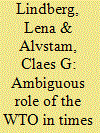|
|
|
Sort Order |
|
|
|
Items / Page
|
|
|
|
|
|
|
| Srl | Item |
| 1 |
ID:
113961


|
|
|
|
|
| Publication |
2012.
|
| Summary/Abstract |
The world trading system is characterized by a growing number of free trade agreements (FTAs). Limited progress in the negotiations at the multilateral level within the WTO has contributed to this development, inducing countries to seek faster, alternative ways to speed up liberalization, which make it possible to take advantage of preferential treatment with key trading partners. This article discusses what role the WTO should take with regard to FTAs in times of stalled multilateral negotiations and proliferating FTAs, and how FTAs can contribute to the multilateralization of regionalism. When results at the multilateral level are scarce, there may be a shift towards other alternatives in which the WTO is left out. This may force the WTO to function reactively, simply facing facts as an organization, rather than proactively, where it may play some role in shaping the FTA development. FTAs are not an entirely separate phenomenon from the WTO, since countries that negotiate FTAs play two roles. They are members of the WTO and as such are part of the work and negotiations of the organization. They are also part of trade arrangements that are limited to a smaller number of countries, and hence can negotiate against the interest of the entire multilateral organization. This article explores how these agreements can facilitate the work and negotiations of the WTO to regionalize bilateralism and multilateralize regionalism, here named the "sticky rice" approach. Various East Asian trade arrangements are used as empirical examples.
|
|
|
|
|
|
|
|
|
|
|
|
|
|
|
|
| 2 |
ID:
086135


|
|
|
|
|
| Publication |
2009.
|
| Summary/Abstract |
The recent proliferation of regional trade agreements in the East Asian region can be seen as the most notable development in the region's trading panorama in recent years. Yet, very little is as yet understood about the anatomy of these agreements and, consequently, their full implications to the regional economy. This article strives to fill this gap by analyzing the structure of four dozen RTAs by their various key component parts, including tariff liberalization schedules, rules of origin, and competition policy, customs, investment, and services provisions. The results reveal that intra-Asian RTAs are generally quite rapidly liberalizing, with the exception of agriculture, but they are also quite thin in trade-related disciplines when compared with the more legalistic US trans-Pacific RTAs and those of Mexico and Chile. The proposed Free Trade Area of the Asia-Pacific would inherently be a construct of the political economy interests of these various constituent RTAs.
|
|
|
|
|
|
|
|
|
|
|
|
|
|
|
|
|
|
|
|
|